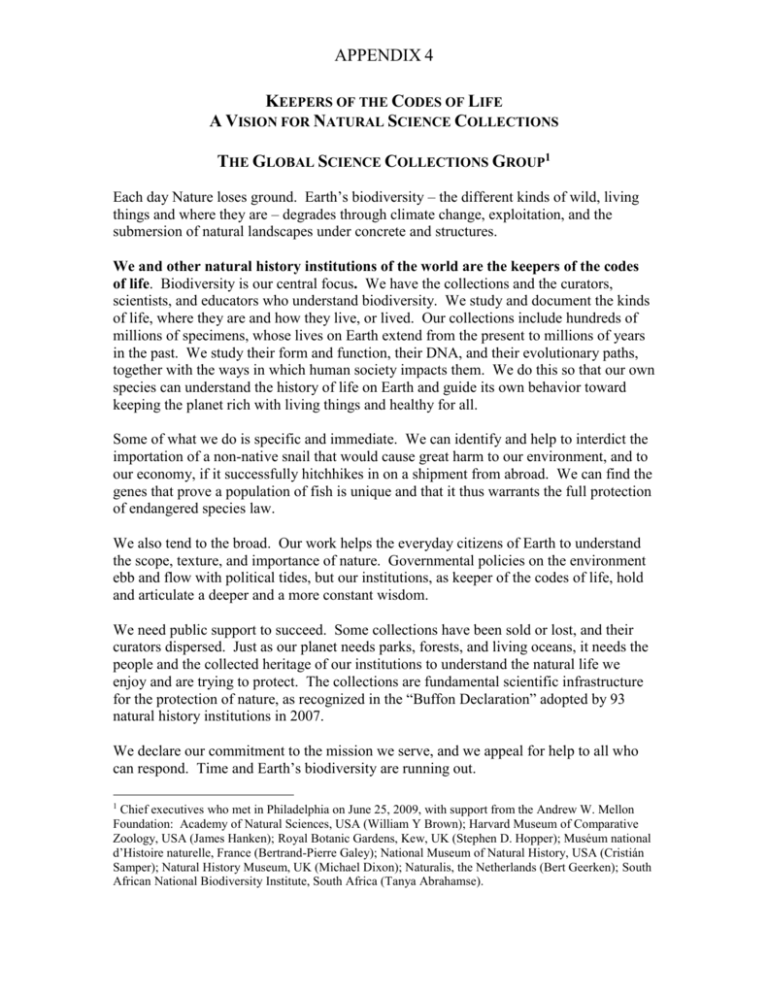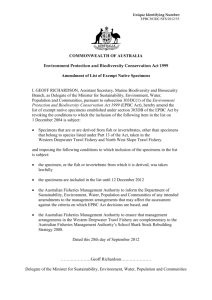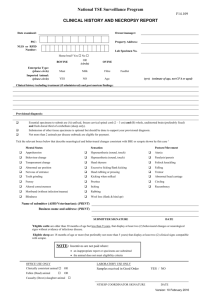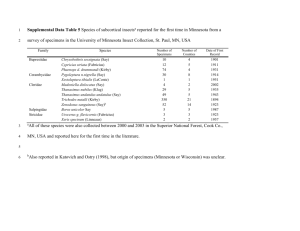here - Natural Science Collections Alliance
advertisement

APPENDIX 4 KEEPERS OF THE CODES OF LIFE A VISION FOR NATURAL SCIENCE COLLECTIONS THE GLOBAL SCIENCE COLLECTIONS GROUP1 Each day Nature loses ground. Earth’s biodiversity – the different kinds of wild, living things and where they are – degrades through climate change, exploitation, and the submersion of natural landscapes under concrete and structures. We and other natural history institutions of the world are the keepers of the codes of life. Biodiversity is our central focus. We have the collections and the curators, scientists, and educators who understand biodiversity. We study and document the kinds of life, where they are and how they live, or lived. Our collections include hundreds of millions of specimens, whose lives on Earth extend from the present to millions of years in the past. We study their form and function, their DNA, and their evolutionary paths, together with the ways in which human society impacts them. We do this so that our own species can understand the history of life on Earth and guide its own behavior toward keeping the planet rich with living things and healthy for all. Some of what we do is specific and immediate. We can identify and help to interdict the importation of a non-native snail that would cause great harm to our environment, and to our economy, if it successfully hitchhikes in on a shipment from abroad. We can find the genes that prove a population of fish is unique and that it thus warrants the full protection of endangered species law. We also tend to the broad. Our work helps the everyday citizens of Earth to understand the scope, texture, and importance of nature. Governmental policies on the environment ebb and flow with political tides, but our institutions, as keeper of the codes of life, hold and articulate a deeper and a more constant wisdom. We need public support to succeed. Some collections have been sold or lost, and their curators dispersed. Just as our planet needs parks, forests, and living oceans, it needs the people and the collected heritage of our institutions to understand the natural life we enjoy and are trying to protect. The collections are fundamental scientific infrastructure for the protection of nature, as recognized in the “Buffon Declaration” adopted by 93 natural history institutions in 2007. We declare our commitment to the mission we serve, and we appeal for help to all who can respond. Time and Earth’s biodiversity are running out. 1 Chief executives who met in Philadelphia on June 25, 2009, with support from the Andrew W. Mellon Foundation: Academy of Natural Sciences, USA (William Y Brown); Harvard Museum of Comparative Zoology, USA (James Hanken); Royal Botanic Gardens, Kew, UK (Stephen D. Hopper); Muséum national d’Histoire naturelle, France (Bertrand-Pierre Galey); National Museum of Natural History, USA (Cristián Samper); Natural History Museum, UK (Michael Dixon); Naturalis, the Netherlands (Bert Geerken); South African National Biodiversity Institute, South Africa (Tanya Abrahamse). 2 THE WAY FORWARD Natural history institutions should be recognized as the primary and default source for identifying and confirming the taxonomic status and the current and historical geographic distribution of species and populations that government agencies and other seek to protect. These institutions should also be the primary and default source for preservation and provision of viable tissue and DNA comprehensively representing life forms. In addition, they should be key sources for biodiversity impact assessment, international biodiversity capacity development, biotic screening for applied uses, and systematicsbased education. Among the many needs and initiatives underway concerning science collections, we believe that priority is warranted for global action on the following steps. PRESERVE VIABLE TISSUE AND DNA OF ALL KNOWN SPECIES Many studies have documented the rapid loss of biodiversity caused by humans, and many policies and programs seek to prevent this. These efforts for conservation in the wild should be complemented with an initiative to preserve viable tissue and DNA of all known species. Beyond their critical role in identification and evolutionary research, such collections may offer the potential to resurrect species after extinction in life. A much larger effort has been made on this front for vascular plants than for animals, presumably prompted by the recognized importance of genetic diversity for agricultural crops. Plant seed banks include, for example, the Millennium Seed Bank Project of Kew Gardens in England, the Svalbard Global Seed Vault on Norway’s Spitsbergen Island in the Arctic, and Department of Agriculture labs in the United States in places such as Fort Collins, Colorado. Investment in such banks is far from complete, but by comparison, animals have hardly been addressed beyond a limited number of commercialized species. Frozen animal tissue specimens and intact DNA extracts provide not only genomes for sequencing but also the potential for generating adult organisms through cloning, as those technologies develop. Facilities for storing frozen animal tissue exist at some at our institutions, but they are limited. The Academy of Natural Sciences, for example, holds some 20,000 frozen bird specimens, representing more than 26 percent of all known species. With leadership from the Natural History Museum and others in the UK, a group of institutions with tissue collections have formed a consortium named the “Frozen Ark.” Member institutions are in the United Kingdom, United States, Australia, New Zealand, India and South Africa. The Frozen Ark Coalition and other individual institutions are moving forward as best they can, but none has yet garnered the high visibility or the support this issue warrants. The goal of preserving viable cells and DNA of all known species can be reached only with proper planning and implementation. Planning is required to define dimensions and protocols, develop a high degree of consensus, and advance a multinational initiative on 3 the issue. Key technical issues include the choice of taxa for preservation and the corresponding collection priorities, the role of type specimens, field and laboratory protocols, storage technology (including alternatives to freezing), facility redundancy, international governance, and funding. Success will require engaging governmental and other donors on a large scale. IMAGE AND DIGITIZE INFORMATION FOR ALL TYPE SPECIMENS Our eight institutions and many others are involved in projects to image their specimens and digitize the data that goes with them. Access to this digital information can be provided immediately over the Web and significantly facilitate the inventory of Earth’s biota and the description of new species. In addition to the cost and time savings from such access, we have found that requests for loans of specimens – where they are physically shipped from the home institution and later returned – have dropped by 80 percent or more when high resolution images are made available. This reduces wear and tear on specimens and eliminates the risk of loss in transit. In addition, imaging provides a back-up representation of the specimen itself in case of accidental loss or damage. The highest priority group for imaging and other digitizing is “type” specimens, those that are used when a given species is first described and remain the physical references or “vouchers” for them in perpetuity. Foremost among these are the “primary” types that are the irreplaceable exemplar or standard for the species. Systematists (people who study evolution and name new species) have always made reference to physical characters of specimens, such as joints, jaws, bones, tentacles, gut, eyes, and color. Nowadays, the DNA of type specimens is also becoming central in their description and placement in the tree of life. Our eight institutions alone hold more than a million type specimens, a large part of which are primary types. The most thorough digitizing initiative has been that for plant type specimens funded by the Andrew W. Mellon Foundation. All eight institutions have participated, and several hundred thousand sheets of dried plants (stems, flowers, fruit and seeds pressed onto sheets of paper) have been imaged at high resolution with a standard protocol. These images are to be made available at jstor.com. The work should now be extended to all type specimens with highest priority given to primary types. Vertebrates and many invertebrates, including insects and mollusks, need three-dimensional imaging. Many institutions have done some work on these, but no generally accepted practices have been followed. As is the case for viable tissue and DNA preservation, the goal of imaging and digitizing information for all type specimens will first require planning, agreement, and communication and then significant funding for implementation. Initial planning on this has begun through collaboration of our institutions and others within an organization named the Global Biological Information Facility or GBIF. However, the work required requires funding that is not currently available at a level commensurate with the task. 4 COORDINATE, SIMPLIFY AND ADVANCE COLLECTION INFORMATION MANAGEMENT Our eight institutions and others are continuously engaged in efforts to improve the systems and practices used to manage our collections and the information related to them and to facilitate access to that information by others. Imaging and other digitizing is a foundation for that, but it must be complemented by information systems and practices that are widely shared by collection institutions. Much work remains to be done. Our institutions and many others maintain electronic databases for collections and provide access to them through the Web. However, there is no unifying Web site that catalogues even the most basic combined collection information on most specimens from multiple institutions, such as the species, date and location of collection, and name of the holding institution. GBIF has established a Web framework for this, yet its data base includes less than 10 percent of the specimens cataloged in natural history institutions and searches at its site are a challenge for the uninitiated. Yet ready access to this kind of information would enormously accelerate collection-based inquiries, including those in pursuit of priorities such as biodiversity conservation and climate change assessment. Much effort is underway to keep and share information on species and specimens in collections. GBIF is a central global initiative for the scientific community, and there are other projects such as International Taxonomic Inventory System (ITIS), Encyclopedia of Life (EoL), Species 2000, and Discover Life. Furthermore, many Web sites are devoted to particular groups of organisms defined by taxa (e.g. frogs) or by topic (e.g. invasive species). Underlying and promoting these initiatives are a mix of private and public enterprises, in good part shaped by national and international policies and programs related to science collections. These include work under global treaties such as the Global Taxonomy Initiative of the Convention on Biological Diversity (CBD), the Convention on International Trade in Endangered Species of Wild Fauna and Flora (CITES), and the Bonn Convention on Migratory Species; international initiatives such as the OECD Science Forum, GEO Bon, European Distributed Institute of Taxonomy (EDIT), and Consortium of European Taxonomic Facilities (CETAF), and a host of national efforts The unmet challenge is how to focus and support this interest in a way that will preserve viable tissue and DNA of all known species, image and digitize information for all type specimens, and, at the simplest level, allow anyone to quickly find out where these, as first priority, and other museum specimens are, and when and where they were collected. An order of magnitude more funding is essential. GBIF and the Encyclopedia of Life are core mechanisms for planning, science and public presentation, but the heavy-lifting must be done, and funded, through the natural history institutions around the world that hold specimens. The United Nations has declared 2010 to be the International Year of Biodiversity. We would be wise to take that seriously. The codes of life are being lost as we speak, and we need to make sure they are preserved and understood before it is too late to know them at all.





